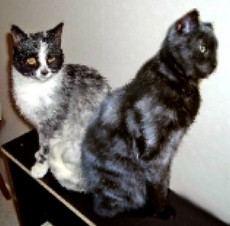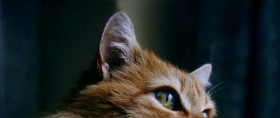
The Vivendi Mosaic has the recessive form of the Phaeomelanin-Selective Dilution gene. This selectively affects any red pigment in the coat. A tortoiseshell or calico cat with one or no copies of the gene (PhPh, Phph) shows the normal red pigments, but a cat with two copies of this ultra-rare recessive (phph) shows dilution of the red colour while any black pigments are left unaffected. This produces eyecatching cats with black and cream markings and either yellow, blue or odd eyes depending on the amount of cream on the face. Modus Vivendi Felines have perfected the stunning black/cream brindle, with the emphasis on black brindling on a cream body and blue or odd eyes. When a red or red tabby has these recessive genes, it becomes a beautiful blue eyed cream.
 These cats are only sold neutered. As well as being a responsible move against overpopulation, this eliminates the danger of the Ph gene entering conventional cat breeds where it would be highly unwelcome.
These cats are only sold neutered. As well as being a responsible move against overpopulation, this eliminates the danger of the Ph gene entering conventional cat breeds where it would be highly unwelcome.
The Vivendi Mosaic is a medium-sized cat with short silky fur which shows the characteristic black/cream markings in either brindle or patched patterns to their best advantage. Blue-eyed creams may also be available.
The foundation cats of this beautiful breed were born in a research laboratory. Recognising the colour as novel, one of the animal care technicians was able to buy the kitten and two of her siblings, saving them from neurological research as well as introducing this new colourway to cat owners. A happy ending for these lucky kittens and an exciting development in cat breeding!
 Unlike previous "white" mutations, the Modus Vivendi Polar White exhibits grey to black skin and colourless hair. The uniquely structured colourless hair appears white, with rainbow sparkles, due to refraction of light. The underlying skin colour is visible when the fur is parted although shortfurred versions may have a subtle ashy colour that is not completely masked by the fur. The nose, eye rims, inside of ears, bottoms of paws and the under-tail area are ash-grey to slate-grey. The exact shade of grey cannot be guaranteed or even selectively bred as it is controlled by developmental factors and not by genes.
Unlike previous "white" mutations, the Modus Vivendi Polar White exhibits grey to black skin and colourless hair. The uniquely structured colourless hair appears white, with rainbow sparkles, due to refraction of light. The underlying skin colour is visible when the fur is parted although shortfurred versions may have a subtle ashy colour that is not completely masked by the fur. The nose, eye rims, inside of ears, bottoms of paws and the under-tail area are ash-grey to slate-grey. The exact shade of grey cannot be guaranteed or even selectively bred as it is controlled by developmental factors and not by genes.
The eyes can be blue, green, orange or hazel. Unlike many blue-eyed white cats, the Modus Vivendi Blue-Eyed Polar White does not suffer from deafness. This is because the white effect is caused by light refraction and not by the colour of fur and skin. Unlike other white cats, odd-eyed white does not occur, again because the skin and fur are actually not white.
Work is ongoing to establish this colour in a range of body types ranging, from svelte to cobby, and in several lengths and types of fur including a ringletted version.

 The Modus Vivendi Roan mixes white and coloured hairs together to give a speckled appearance. Depending on how many Roan genes are inherited, the effect ranges from white with colour flecks ranging from speckled (coloured flecks of just a few hairs) and spotted (small random coloured spots), through to an even mix of colour and white hairs in the coat (pepper and salt effect) and finally coloured with white spots or flecks (snowflake). A few cats have the ultra-rare and highly coveted "cobweb" or "lace" effect and are individually priced.
The Modus Vivendi Roan mixes white and coloured hairs together to give a speckled appearance. Depending on how many Roan genes are inherited, the effect ranges from white with colour flecks ranging from speckled (coloured flecks of just a few hairs) and spotted (small random coloured spots), through to an even mix of colour and white hairs in the coat (pepper and salt effect) and finally coloured with white spots or flecks (snowflake). A few cats have the ultra-rare and highly coveted "cobweb" or "lace" effect and are individually priced.
The end result colour depends on the original coat colour and on the amount of roaning. Neutered kittens will be available in the following colourways.
On sleek, shiny shorthairs, the 15 colourways are:
Strawberry roan or speckle/spotted or snowflake
Black roan or speckle/spotted or snowflake
Grey roan or speckle/spotted or snowflake
Tortie roan or speckle/spotted or snowflake
Grey-Tortie roan or speckle/spotted or snowflake
On silky-soft longhairs, the 15 colourways are:
Deep/mid/pale strawberry haze
Deep/mid/pale ash haze
Deep/mid/pale blue haze
Deep/mid/pale Tortie haze
Deep/mid/pale Grey-tortie haze
For those interested in genes, the salt-and-pepper gene, sometimes called tweed, was first seen in feral cats and domestic shorthairs. Since these had been neutered and could not be bred from, it became necessary to clone the neutered cats to get breeding stock. This was successful and their progeny were interbred and refined using European Burmese and Asian Longhairs to get the glossy coat and a body that is neither too cobby, nor too skinny. Using modern technology, this exciting mutation has been rescued from extinction!

For genetics enthusiasts, Rust is known as the Eumelanin/Phaeomelanin Switch. This means it converts solid black pigment into solid red pigment. The end result depends on whether the cat is genetically black, chocolate or cinnamon (light chocolate). It was first noted in Bengal cats and is believed to have originated in early Bengal crosses, perhaps coming from the Asian Leopard Cat itself! This eye-catching colour is not accepted in Bengals so Modus Vivendi have taken pedigree Bengals with this gene and used them to develop the Modus Vivendi Rust series.
Modus Vivendi breeds 3 colourways, all with a sleek glossy coat and Siamese body type. These are deep red (genetically black), rust (genetically chocolate) and light red (genetically cinnamon). Unlike other "red" cats these have absolutely solid colour with no tabby markings once the adult coat develops.
Because the gene only affects the solid colours in the coat, glossy shorthaired classic tabby and spotted cats with red patterns on a grey, brown or silver background will also be available. Imagine a grey cat with swirled red markings or a silver cat with deep red spots!

The Modus Vivendi Bay series is expected to become available in 2014 once the genetics are properly understood. The effect, a non-agouti modifier, depends on whether the cat is genetically black, chocolate or cinnamon.
 The effect depends on the other colour genes present. A solid black cat will be solid red (deep ginger) with black points (black bay). A chocolate cat will be solid pale red with black points (chocolate bay). A cinnamon will be yellow-dun with black points (cinnamon bay). If the cat is tortoiseshell, there will be red brindling or patches interspersed with these colours, but this is not a desirable effect and they will only be sold as Modus Vivendi Variants.
The effect depends on the other colour genes present. A solid black cat will be solid red (deep ginger) with black points (black bay). A chocolate cat will be solid pale red with black points (chocolate bay). A cinnamon will be yellow-dun with black points (cinnamon bay). If the cat is tortoiseshell, there will be red brindling or patches interspersed with these colours, but this is not a desirable effect and they will only be sold as Modus Vivendi Variants.
If the colour dilution gene is present: black-bay become pink-grey with charcoal points while both dilute chocolate bay and dilute cinnamon bay are transformed into warm-pearl-grey with charcoal points. If the cat is tortoiseshell, there will be fawn brindling or patches interspersed with these colours, but this is not a desirable effect and they will only be sold as Modus Vivendi Variants.
The Modus Vivendi Bay was a natural development from the Modus Vivendi Rust breeding program, resulting from a spontaneous mutation.


